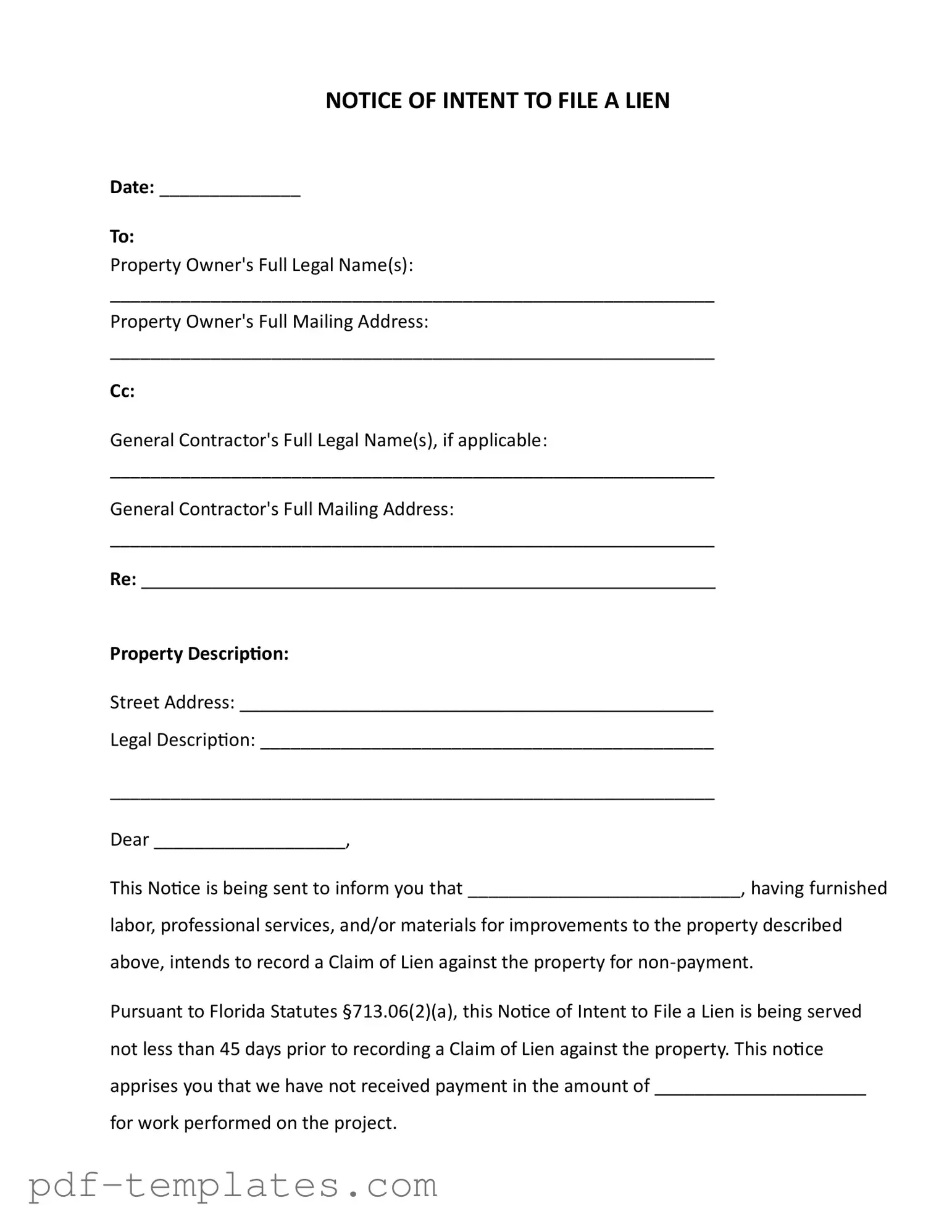The Notice of Commencement is a document that serves as a formal declaration of a construction project. It is typically filed by the property owner before any work begins. This document provides essential information, including the property description and the general contractor's details. Like the Intent to Lien, it aims to protect the rights of those who provide labor or materials by notifying interested parties of the project's existence. Both documents play a crucial role in the construction process and help establish a clear chain of communication among stakeholders.
A Notice of Non-Payment is issued when a contractor or subcontractor has not received payment for services rendered. This document alerts the property owner and other parties that payment has not been made and that further action may be necessary. Similar to the Intent to Lien, it serves as a warning that a lien may be filed if the situation is not resolved. Both documents emphasize the importance of timely payment and communication to prevent legal complications.
A Claim of Lien is a legal claim against a property for unpaid services or materials. Once filed, it provides a public notice of the contractor's right to seek payment through the property itself. The Claim of Lien follows the Intent to Lien and is often the next step if payment is not received. Both documents share the goal of ensuring that those who contribute to a property are compensated for their work, highlighting the importance of financial accountability in construction projects.
The Lien Waiver is a document that releases a contractor's right to file a lien against a property once they have been paid. This document is often used to provide assurance to property owners that no further claims will be made for the completed work. While the Intent to Lien warns of potential claims, the Lien Waiver confirms that all obligations have been met. Both documents are critical in managing the financial aspects of construction and protecting the interests of all parties involved.
The Affidavit of Payment is a sworn statement confirming that all subcontractors and suppliers have been paid for their work on a project. This document is often required before a property owner can receive a final payment or release of lien. Like the Intent to Lien, it underscores the importance of financial transparency in construction. Both documents help ensure that all parties are informed about payment statuses, reducing the risk of disputes.
A Notice of Final Payment is issued to inform all parties that the final payment has been made for a construction project. This document serves to close out the project and provides clarity regarding any outstanding financial obligations. Similar to the Intent to Lien, it helps maintain clear communication among the parties involved, ensuring that everyone is aware of the project's financial conclusion.
The Certificate of Satisfaction is a document that confirms a lien has been satisfied and released. This document is filed after payment has been received and serves to inform the public that the lien is no longer valid. Both the Certificate of Satisfaction and the Intent to Lien deal with the status of financial obligations related to a property. They help protect the rights of contractors and property owners by clearly documenting the resolution of payment issues.
The Mechanic's Lien is a specific type of lien that can be filed by contractors, subcontractors, and suppliers who have not been paid for their work on a property. This document allows them to seek payment through the property itself. Similar to the Intent to Lien, it serves as a legal mechanism to enforce payment and protect the rights of those who contribute labor or materials. Both documents are essential tools in the construction industry, ensuring that financial disputes are handled appropriately.
In California, additional forms are often crucial for ensuring that financial obligations are met, one of which is the All California Forms that include the California Loan Agreement form. This form serves to outline the legal agreement between lenders and borrowers, specifying all necessary aspects such as the loan amount and repayment terms, thereby protecting both parties in a financial transaction.
The Demand for Payment is a formal request for payment that can be sent to a property owner or general contractor. This document outlines the amount owed and the services provided. Like the Intent to Lien, it serves as a precursor to more serious legal action if the payment is not made. Both documents emphasize the need for timely communication and resolution of financial issues in construction projects.
